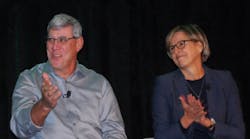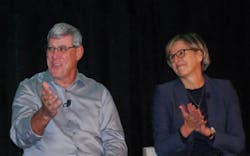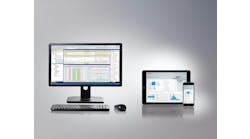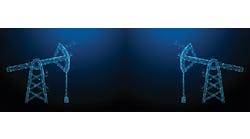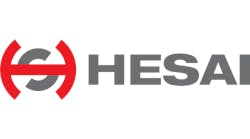“Gary is leaving the process automation business in quite good shape. We’ll continue investing and developing, maintaining our customer commitments, investing in automation and safety technology, and accelerating your digitalization.” Gary Freburger (left) announced his retirement and the appointment of Nathalie Marcotte to the post of president, Process Automation, Schneider Electric, effective at the end of this year.
“We are surrounded by digital technology, on our wrists, in our pockets, in rings, ears, cars, homes—and industrial plants,” said Michael Martinez, manager, Digital Transformation Consulting, Schneider Electric. “The need for contextualized data to make better decisions is driving us down this path, whether we like it or not.”
Martinez emceed the opening session of Schneider Electric’s Innovation Days, attended by users of its Foxboro and Triconex brands, this week in Austin, Texas. This year’s theme is “Digitize to work smarter, safer, better,” and the session described how Schneider Electric and its customers are working together to achieve digital transformation.
The path starts with digitization: storing information as data instead of on paper or in our memories, said Martinez. The next step is digitalization, when the information is used to improve business performance. Then comes digital transformation, including revising work models and the creation of new businesses.
“Enabling infrastructures define our capabilities and must be consistent and adaptable,” Martinez said. The most basic level is isolated platforms—separated analog and digital components and systems. “Next is sharing data in systems of systems,” he said. “The most advanced is networked platforms—an intranet of systems or Internet of things—where data flows freely, opening up our possibilities.”
Where are you on your journey? Are your systems isolated and repeatable? Isolated and adaptable? Distributed and repeatable? Distributed and adaptable? Networked and repeatable? Networked and adaptable?
“Companies use the technology they need for business, and the business environment is changing dramatically,” Martinez said. We see this in our personal lives in how we order a meal or shop online. Brick-and-mortar businesses must compete. “What’s happening in your industry?”
For example, power generation and distribution is disrupted by renewables. E-mobility—electric cars—brings a need for new technologies and infrastructure to improve range and provide charging stations. Sustainability demands new products, such as paper straws.
“You have to innovate to stay relevant,” Martinez said. Then the geopolitical landscape brings growing cybersecurity concerns.
Your guide to transformation
“We’ve been talking about digital transformation for about five years,” said Gary Freburger, president, Process Automation, Schneider Electric. In the beginning, it was about connectivity—getting data. “When we talked about cloud computing, customers were not interested. Now, the cloud is everywhere, along with fog and everything that goes with it,” Freburger said. “But how do we go about doing it? What’s the value?
“Schneider Electric has experience and understands the value we can create with you. Many other companies—good companies—haven’t been successful. We bring domain expertise, not just in automation, but with the rest of our portfolio. The technology continues to change, hardware and software. We can bring these things together, into your environment, to do what you want to do today.”
Our EcoStruxure architecture is a good example of success, Freburger said. “The digital team takes that technology across the board with a Schneider Electric approach.” Standards such as for cybersecurity are key, Freburger added. “We’re a founding member of ISA’s cybersecurity standardization initiative, which is key to how this technology is going to work.”
According to Aleksandr Rakitin, director, Digital Business Design for Schneider, a team of Schneider digital designers has been doing research with users to understand “the tools they use, their friction and pain points, learning how to ideate, instigate and industrialize digital transformation, with business models. The approach doesn’t replace subject-matter expertise or client infrastructure. It’s scalable, and talks to the real needs on the ground.”
Rakitin said Schneider Electric and its customers are going through digital transformation together. “We’re experimenting together with our customers,” he said. “The technology is abundant. We look at it through the lens of the user persona and the user use case, what it means to them and how to help them do their jobs.”
Nathalie Marcotte, senior vice president, Industrial Automation Services and Cybersecurity, at Schneider Electric, said, “We look at our existing lifecycle services and see how we can improve them, and also help clients accelerate transformation with technology and cybersecurity.”
Schneider Electric has set up a digitalization consulting organization to help clients to quantify opportunities. “For example, we find $20 million in value,” Marcotte said. “Then we help them decide which you do first, how, and with cybersecurity.”
The company has digitalized its own factories. “We show clients and share our process and our experience with transforming people, as well as technology," said Marcotte.
“We bring value built on foundations such as Process Safety Advisor that includes SIF Manager to tell you in real time how safely your plant is running,” Marcotte said. “Our cybersecurity team is doing assessments on OT with all the installed systems, not just ours.
“We give clients a roadmap, and they can work with us and our partners. We started with oil & gas, and now we’re rolling it out to all industries.”
Changing the subject
Freburger then announced that he is retiring at the end of the year, and Marcotte will be taking over. “Gary is leaving the process automation business in quite good shape,” Marcotte said. “We’ll continue investing and developing, maintaining our customer commitments, investing in automation and safety technology, and accelerating your digitalization.”
In conclusion, Martinez encouraged attendees to “engage, engage, engage. Take advantage of our resources, wherever you are on your journey. Where do you see your company in five years? Will you be doing more of the same or something completely different? Choose to take the next step on your digital journey.”
